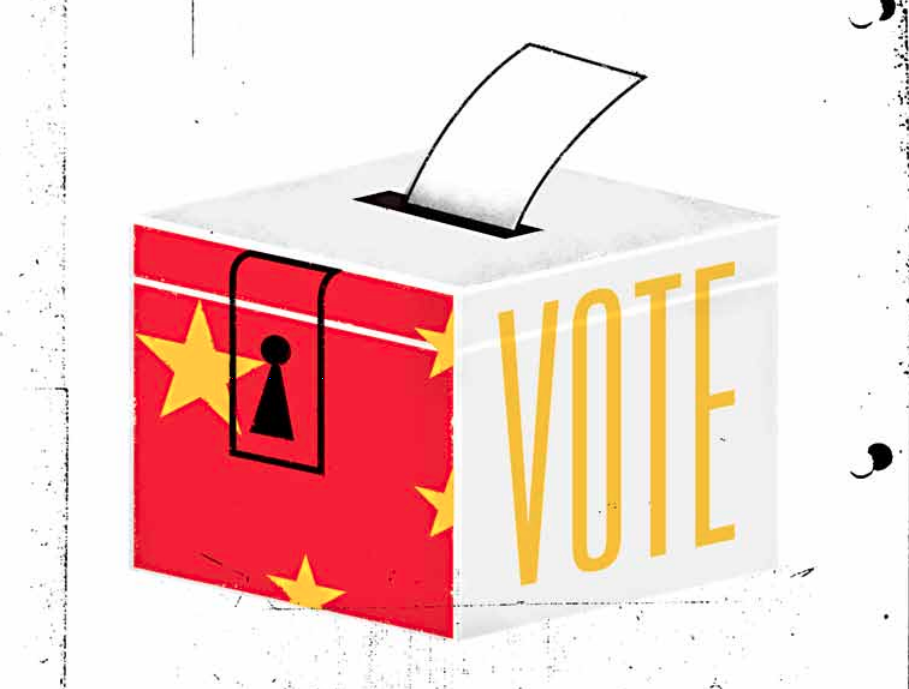On April 3, 2011, Chinese artist Ai Weiwei was detained by police just prior to boarding a flight to Hong Kong. He has been held incommunicado since. [Ed. note: He was released on June 22, after this article went to press.] Ai—known internationally as much for his far-ranging artistic projects as his criticisms of the Chinese government—is but one of many, perhaps thousands, of “troublemakers” rounded up by the Chinese government in recent months. Ai may be the most recognizable name globally, but other detainees have included rights activists, lawyers, bloggers, journalists, and academics. Some have been formally charged with “creating a disturbance” or “inciting subversion”; others have been disappeared through extra-judicial procedures.
The exact motivations behind the government’s expanding crackdown are uncertain, but it is safe to assume that images of Egypt and Tunisia loom large. Indeed, back in February and March, China too appeared caught in the undertow, with hints of a homegrown “Jasmine Revolution.” But the Jasmine Revolution drew small crowds and little energy. The dominant story soon became one of unyielding political repression and conspicuous public silence.
In the West this situation has inspired renewed focus on repression in China, with extensive coverage in The New York Times, The Washington Post, The Times of London, Le Monde, and elsewhere. At one level is concern for the detainees themselves, individuals who appear to have done nothing wrong but have been swallowed up by a criminal justice system affording them neither due process nor mercy. At a deeper level are geopolitical or even existential worries about what the Chinese government’s behavior signifies for a nation that is now a leading global power. Seemingly out of nowhere, China has emerged as the world’s fastest-growing major economy, the largest overseas holder of U.S. government debt, the largest exporter, and the largest emitter of greenhouse gases. And along with jaw-dropping technological advancement in the domestic economy, China has invested in military modernization. Yet even as China becomes a nation of global caliber, it appears governed by individuals determined to play by their own rules and to respect no limits to their exercise of power.
But why should the recent detentions arouse particular anxiety? After all, it is hardly news that China is governed by an authoritarian system. Extrajudicial detentions and reflexive repression of dissent—whether real or imagined—have always been the method of authoritarian regimes. We see it today in Syria, Libya, Russia, Vietnam, and elsewhere. And we saw it just a few decades ago in Argentina, Chile, Guatemala, and even Mexico.
The variety of nations (and political outcomes) on this list suggests that abuse of dissenters—conspicuous in spite of overseas condemnation—is characteristic of not just sclerotic, immovable regimes, but also of authoritarian systems undergoing profound processes of change and liberalization. It would be wrong to read the current crackdown as a sign of stasis or regression. Though there has been no “Chinese Spring,” in fundamental institutional, organizational, and behavioral terms, it would be hard to describe what has transpired in China over the past twenty years as anything but a revolution.
Lessons From South Korea and Taiwan
Those who doubt that profound change and harsh repression can coexist in China should look to the history of South Korea and Taiwan. In January 1987, just seven years after a democratic uprising was crushed in the South Korean city of Gwangju and a few months before the military-backed regime would yield to popular demands for open elections, student protestors were being summarily rounded up by the police. At least one of the students died during interrogation. That same year Taiwan’s Kuomintang government announced the end of 38 years of martial law, a key step toward the establishment of democracy there. But in the months before the announcement, dissenters were still being shipped off, often by secretive military tribunals, to the notorious gulag on Green Island. Crackdowns on opponents, extrajudicial detentions, and violence are often the last-ditch efforts of authoritarian regimes.
Those who doubt that change and repression can coexist in China should look to the history of South Korea and Taiwan.
Perhaps because of their willingness to use force even in their final days, these regimes can appear impervious to change and determined to remain in power. Given the empirical evidence available in the mid-1980s, one could reasonably have described Taiwan’s single-party state as “flexibly” authoritarian: grudgingly willing to mollify the populace with marginal institutional changes, but prepared to employ the gun to defend its grip on power. No one could have been sure whether the Taiwanese government—or South Korean, for that matter—would hold onto power indefinitely, succumb to violent overthrow precisely because of its resistance to change, or yield peacefully and voluntarily to popular desires for liberalization. The same can be said of China today.
The cases of Taiwan and South Korea also suggest that we should be cautious about the frequent observation that politics in China has lagged economics. Both Taiwan and South Korea, right up until the end of the democratization process, were successful and creative on the economic front but politically retrograde. At minimum the lesson here is that the absence of overt regime change doesn’t tell us much.
That leads to a final point about the Taiwanese and South Korean experiences, one equally applicable to the contemporary Chinese scene. Even as authoritarian regimes and their supporting institutions remain in place, subtle political shifts may be under way. Such shifts can include recomposition of the ruling establishment (i.e., the ruling party stays in place, but it ends up populated by new kinds of members), societal pluralization, depoliticization of daily life, and evolving efforts at regime legitimization—efforts that often lead to major changes in political discourse and participation. Ruling elites may push such changes with the most conservative intentions. The goal may be nothing more than regime survival. However, as the cases of Taiwan and South Korea show, such processes can take on a life of their own with members of the state and ruling establishment swept up in the wave of new attitudes, aspirations, and values. And that wave may crest suddenly or over the course of years.
The Economy Reaches Out
There are undoubtedly numerous differences between the China of today and the South Korea and Taiwan of yesterday. But in terms of sociopolitical change, China is increasingly looking like its previously authoritarian East Asian neighbors.
Since the early 1980s China has experienced no political revolution, no definitive ideological break from the past, and nothing even resembling a nationwide political movement. Since Deng Xiaoping’s death in 1997, the country’s leaders have been conspicuous for their lack of charisma and vision. The sprawling Communist Party-state—inheritor of a 1400-year-old tradition of technocratic and highly interventionist bureaucratic rule—grinds on. On the surface, nothing has changed.
But under the surface, virtually everything has. The transformations are particularly striking in the urban industrial economy. At one time China exported almost no manufactured goods; now Chinese industry is deeply immersed in global supply chains. At the dawn of reform in 1978, virtually all Chinese industry was owned by the state. By 2008, in an industrial economy that had grown more than 25-fold, private firms were the dominant players, with foreign firms not far behind. That which was once allocated hierarchically by the state—basic commodities, industrial inputs, manufactured goods, labor (both high-skilled and low), housing, and health care—is now purchased in commercial markets. All manner of new rules have been developed to manage these markets: enterprise law, contract law, labor law, environmental regulations, and so on. And new actors populate core industrial and bureaucratic structures: private entrepreneurs, elite returnees from overseas, domestically trained technocrats, multinational commercial and financial elites, legal professionals, media professionals, and even self-described policy activists and social entrepreneurs. Once-taboo business entities are now vital to the national economy. In 2001, private entrepreneurs—capitalist roaders par excellence—were officially welcomed into the Chinese Communist Party.
Economic changes strike at the heart of the relationship between citizen and state.
And China’s new professionals are not just in business. Of the 1.6 million citizens China has sent abroad for a year or more of study over the past 30 years, approximately 500,000 have returned, and a portion of these returnees now accounts for about a fifth of government ministers and vice-ministers. As Huiyao Wang of the Center for China and Globalization has documented, 78 percent of university presidents and 72 percent of directors of key state-run research labs are returnees. The Party has publicly declared a goal of recruiting 20,000 returnee scholars, entrepreneurs, researchers, and corporate executives to serve in positions of public administration.
With these changes in economic organization and labor, everyday habits have been radically transformed. Finding a job on one’s own, living in a dwelling of one’s own, communicating routinely with acquaintances extending beyond the workplace, working closely with global counterparts, expecting that the wealth and social circumstances enjoyed abroad are China’s destiny as well—all were unimaginable 30 years ago but today are routine. Hardly relegated just to the economic realm, these changes strike at the heart of the relationship between citizen and state.
New Ways of Life
The hierarchical structures of the command economy bound citizen and commercial producer alike directly to the state. In the “old” days, from the 1950s through the early 1990s, if you were an urban citizen, you were most likely assigned to your employer—for life—by the state, housed by the state, and provided health care by the state. As Andrew Walder has described, these were mechanisms of political control that enforced citizen dependency upon the state. If you misbehaved politically, you could be squeezed out of your job, your home, etc.
Under this regime your social interactions were mostly limited to the physical confines of your workplace: not only did you work there, you lived there, and your future was determined there. In all likelihood, you would have had no telephone, no form of transport save a bicycle, and few social ties that would have encouraged you to travel. If you did want to travel, you probably would have needed your employer’s permission to buy the train ticket.
Today, for better or worse, virtually all of those control mechanisms are gone, replaced with freewheeling markets. As a Chinese citizen you now live where you can afford; work where you can find a job, often in a highly competitive labor market; and secure life necessities—everything from education to health care—primarily by shelling out cash. Whether rich or poor, you will almost certainly have a cell phone, and you will likely have a wide variety of social contacts.
In this new system state authority and the nature of state-society relations are radically different, a reality confirmed by the state’s frenetic effort to develop new rules to maintain control and influence. As a response to changing expectations of the role of the state, a new discourse of law-based governance has emerged. In addition to new tax, contract, property, and environmental laws, the state has promulgated national regulations on open government information—China’s Freedom of Information Act, in a sense. Some provinces, such as booming Fujian, have new labor rules that emphasize collective bargaining.
This does not mean that the system is fair or that the state has abandoned coercive and arbitrary intervention. Nor is every element of the state apparatus fully committed to implementing and enforcing these rules. But they would not exist at all if the state were still the main producer, wage payer, housing provider, and on-the-job enforcer in the industrial economy. And, by expressing rules in the language of law, the state, whether intentionally or not, has legitimized a broad discourse about the appropriate bounds of political authority and the responsibilities of an effective government.
This novelty and diversity—in organizations, actors, laws, discourses, and life choices—has created space for the reconfiguration of informal norms and deep-seated values. For instance, in the 1980s to label oneself a private entrepreneur, let alone entrepreneurial tycoon, was to invite arrest. Today that label invites admiration and elevated status.
New-Look State
China’s institutional transformation is hard to see in part because it has diverged from standard theoretical accounts of how change is supposed to take place. In China institutional change has been incremental and evolutionary, radical in its ultimate effect, but hardly in its origin and unfolding. Change has not come in response to exogenous shocks or what Ira Katznelson has called “unsettled times.”
It is also difficult to identify who is responsible for change. For at least fifteen years, there has been no charismatic leader or coherent group of reformers of the type associated with post-Soviet Russia. There are no visionary policy elites negotiating the complex terrain of domestic politics. None of the recent “administrations” have had a discernible institutional mission, whether to end socialism, build capitalism, privatize industry, or seek any of the other systemic transformations articulated by post-socialist reformers elsewhere.
More than a third of Communist Party members hold a college degree or higher, a far cry from the party’s peasant roots.
But—despite the persistence of an authoritarian, single-party state—the composition of elites drawn into the policy process has evolved. Whereas in the early 1990s, for example, overseas-trained returnees were held suspect, barred from positions of influence, today such individuals routinely populate the high echelons of the state economics bureaucracy. The minister of science and technology earned a PhD in Germany, where he subsequently worked for a decade at Audi. The number-two official at the central bank—and the head of the State Administration of Foreign Exchange—earned a PhD in the United States, where he was a tenured professor of economics. The head of the government’s banking regulatory commission has an MBA from the University of London; the head of the Shanghai government’s Office for Financial Services is a Stanford-trained economist; and the list goes on. Twenty years ago, these people would not have returned to China, let alone been appointed to positions at the core of the state.
The absorption of trained professionals into the state bureaucracy does not alone make for political transformation, but this pattern is consistent with a broader shift within the Communist Party to a more urbanized, professionalized, and educated membership. By 2010 the Party had grown to a record 78 million members, nearly a quarter of whom—at least by official accounts—are under the age of 35. More than a third of all Party members hold a college degree or higher and by 2007 just under 3 million Party members were working in private companies and an additional 800,000 or so Party members were self-employed, all of which suggests that the Party’s ideological roots in the rural peasantry and military are withering. And demand for Party membership is up. In 2009 only 10 percent of the applicant pool was admitted. We can, and probably should, argue about the quality of the data, but the overall trends seem fairly clear: the kinds of people who were running away from the Party—and China more broadly—following the Tiananmen crackdown are now the kinds of people competing to enter it.
Some might interpret this as Party-state co-optation. In the 1970s and ’80s, one could have said the same about the efforts of the Kuomintang to recruit technocratic elites, particularly native Taiwanese who had previously been shut out. Co-optation may well have been the intention, but the ruling establishment ended up populated by professionals who, while not revolutionaries, harbored no personal loyalty to the existing system and had little to gain by fighting for it. For many of these technocrats, the Kuomintang was just a vehicle for effecting change in the present. Once its utility in that role had been exhausted, it could be abandoned.
Driving Evolution
While there have been changes within the Party, and there is potential in that change, it is clear that the political establishment is responding to day-to-day institutional evolution elsewhere, not leading it. The example of Delta Electronics illustrates the point and brings together the disparate strands of economic, social, and political change in China.
The assembly of power supplies (the transformer “bricks” and accompanying cords) for laptops is typical of the kind of electronics manufacturing that takes place in China today. Most of these power supplies are produced by a single Taiwanese-owned conglomerate, Delta, which does much of its manufacturing assembly on the Chinese mainland. Fifteen years ago “manufacturing assembly” in China meant screwing together finished, imported parts. The institutional demands of accommodating these low-skill activities were relatively unobtrusive: sweatshop manufacturing did not challenge the establishment’s social and political comfort zone.
Today manufacturing assembly means something else, in part because manufacturers have sought to redefine it, and also because institutional changes have enabled and even forced that redefinition. In order to stay competitive and hold on to key customers such as Apple, HP, and Dell, Delta has to be able to design new power supplies, often on very short notice. This is because customers—the brand-name firms that conceptualize products—are increasingly pushing design tasks downward to their suppliers. The suppliers respond by enhancing their design capabilities in order to bind the customer more closely to them and increase the burden of switching to another supplier.
In Delta’s case customers have been demanding smaller and smaller power bricks. In a matter of weeks, Delta must be able to make a product to-spec, at low-cost, and in enormous quantity. In order to meet the engineering challenges these demands present, Delta has established research-and-development centers within easy driving distance of its manufacturing operations. Those R&D centers are run not by Taiwanese citizens, but by returnees from the United States: Chinese citizens who, after receiving advanced engineering degrees and working in Silicon Valley or other high-tech regions, have elected to return home. But if they are to come back, Chinese society has to accommodate the salary structures and housing they want, as well as the information access—and therefore high-tech infrastructure—they need in order to do their work. (Accommodation of this societal group overlaps with that of purely domestic entrepreneurs and researchers who are diving into global business operations.)
China has not surged forward economically while remaining frozen in place politically.
Returnees alone, though, do not make R&D centers function. They lead a staff, which today is composed of young graduates from China’s top science and technology universities: Tsinghua, Zhejiang, and Shanghai Jiao Tong. In order to take on the advanced design challenges Chinese companies now face, these young engineers needed an education decidedly different from the kind Chinese universities provided even fifteen years ago. The curricula of China’s top universities had to be revamped. More important, the criteria for selecting faculty were transformed as well.
Chinese universities—all state-controlled—were once closed-off communities shaped by rigid systems of seniority and internal promotion. Curricular reform—not to mention the hiring of outside experts—was aggressively resisted. In recent years, that resistance has been effectively quashed. The state has made overt efforts to break down barriers: the Chinese ministry of education requires—through the use of quotas—that universities have both overseas-trained faculty and domestic PhD recipients on their staffs. More subtly, many of these highly trained individuals—whether through their roles as policy advisors, public intellectuals, or commercial consultants—have become increasingly influential in shaping public attitudes and expectations.
All of these activities have been possible only because so much of the old system—economic, social, and political—has been tossed into the dustbin of history. For China to maintain its position as a center for high-tech manufacturing, commercial producers and the institutional environment both needed, and continue to need, upgrades. The aggressive and purposeful fostering of this dynamic has in turn led to surprising reconfigurations of societal power and unexpected openings for previously shunned individuals.
None of these changes, substantial though they may be, prove that China is on a path of democratization exactly like that traveled earlier by Taiwan and South Korea. What the changes do suggest, however, is that we should be cautious about reading too much into immediate political circumstances, such as the recent crackdown. In normative terms, we are right to condemn the crackdown. We are right to be concerned and to voice those concerns publicly. At the same time, we end up on shaky ground if we treat the events of the day as prima facie evidence of political stasis or institutional rollback. China has not surged forward economically while remaining frozen in place politically, and it is hard to argue that the Chinese government will tolerate only those changes that do not threaten its fundamental hold on power, the implication being that China has yet to experience anything approaching real political change. It would certainly be unwise to base public policy upon such premises.
Nobody can say for sure where China is headed. The real issue, though, involves interpreting where China is today and how it has arrived at this point. Whether with regard to China’s growth story or its current stifling of dissent—and especially with regard to the relationship between them—this is not about connecting the obvious dots. Rather, it is about correctly identifying, with plenty of room for debate, what the dots are and how they relate to one another causally. To make sense of what is unfolding right now, and to fully appreciate the range of possible outcomes, we have to acknowledge that profound change, both economic and political, has taken place in China in recent years. In places such as Taiwan and South Korea, brutal crackdowns on dissent were among the last vestiges of authoritarian rule. In contemporary China that could also be true. Indeed, given the last twenty years of change, it seems not just possible but likely.








